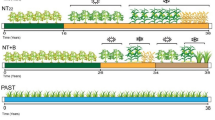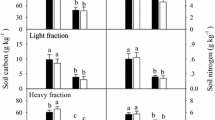Abstract
Purpose
Light fraction soil organic matter is characterized by rapid mineralization due to the labile nature of its chemical constituents and to the lack of protection by soil colloids. The changes in the size of light fraction soil organic matter constituents are useful early indicators of management-related carbon (C) and nutrient changes. However, previous studies have not assessed the impacts of forest management practices on the chemical composition and sources of organic matter in the light fraction. The change in the chemistry of light fraction soil organic matter may significantly affect turnover rate of organic matter in the whole soil and soil fertility. The aim of this study was to assess how different forest management practices would affect the chemical composition of light fraction soil organic matter.
Materials and methods
Soils in 0–5, 5–15, and 15–25-cm layers were sampled in 2009 from a 19-year-old second-rotation Pinus radiata D. Don plantation. Soils were subject to four different treatment combinations (stem-only and whole-tree harvesting residue management treatments were combined with the presence or absence of nitrogen (N)). The soil was physically separated into two pools based on density fractionation. The C and N concentrations in the whole soil, light, and heavy fractions were determined. Light fraction soil organic matter in upper soil (0–5 cm depth) was analyzed by solid-state CPMAS 13C NMR and GC/MS to determine the effects of forest management practices on the composition of organic C functional groups and the relative abundance of plant biomarkers.
Results and discussion
Long-term fertilization did not affect the C and N concentrations in the whole soil, light and heavy fractions, but increased the relative enrichment of alkyl C and alkyl-to-O-alkyl C ratio in the light fraction soil organic matter at the 0–5 cm depth, which may suggest increased decomposition of the light fraction. The relative abundance of cutin-derived compounds, which originate from the waxy coating of leaves, was greater in the light fraction soil organic matter in the fertilized plots than in the unfertilized plots. The relative abundance of major carbohydrates, labile components in the light fraction soil organic matter, decreased in the fertilized plots despite greater inputs from forest litter, compared to that in the unfertilized plots. Compared with whole-tree harvest plots, stem-only harvest plots had greater C concentrations in the light fraction soil organic matter at 0 to 25-cm layer and seemed to have a greater alkyl-to-O-alkyl ratio in the light fraction of soil organic matter, but the difference in alkyl-to-O-alkyl ratio due to harvest residue management was not significant (P < 0.05) at the 0–5 cm depth. Post-harvesting residue management did not significantly affect functional organic C groups as analyzed by CPMAS 13C NMR, or the relative abundance of cutin, suberin, lignin-derived compounds or major carbohydrates determined by GC/MS.
Conclusions
The analyses of light fraction soil organic matter suggest that long-term fertilization did not affect the C concentration of light fraction soil organic matter, but increased the relative enrichment of recalcitrant C possibly due to enhanced input of cutin-derived compounds, decreased decomposition of cutin-derived compounds, or increased decomposition of less recalcitrant compounds. Stem-only harvesting residue management enhanced C concentration in the light fraction soil organic matter; however, it did not significantly affect the relative abundance of recalcitrant or labile C components compared to whole-tree harvesting. The information on chemistry of light fraction soil organic matter may contribute to the future nutrient and soil C management in the second-rotation plantation.

Similar content being viewed by others
References
Boone RD (1994) Light-fraction soil organic matter: origin and contribution to net nitrogen mineralization. Soil Biol Biochem 26:1459–1468
Carlyle JC (1993) Organic carbon in forested sandy soils: properties, processes, and the impact of forest management. New Zeal J Forest Sci 23:390–402
Carter MR, Gregorich EG (2008) Soil sampling and methods of analysis. CRC Press, Boca Raton, FL
Compton JE, Boone RD (2002) Soil nitrogen transformations and the role of light fraction organic matter in forest soils. Soil Biol Biochem 34:933–943
Dubeux JJCB, Sollenberger LE, Comerford NB, Scholberg JM, Ruggieri AC, Vendramini JMB, Interrante SM, Portier KM (2006) Management intensity affects density fractions of soil organic matter from grazed bahiagrass swards. Soil Biol Biochem 38:2705–2711
Hewitt AE (1992) New Zealand soil classification. DSIR Land Resources, Lower Hutt, p 133
Homann PS, Caldwell BA, Chappell HN, Sollins P, Swanston CW (2001) Douglas-fir soil C and N properties a decade after termination of urea fertilization. Can J Forest Res 31:2225–2236
Huang Z, Xu Z, Chen C, Boyd S (2008) Changes in soil carbon during the establishment of a hardwood plantation in subtropical Australia. Forest Ecol Manag 254:46–55
Huang Z, Clinton PW, Baisden WT, Davis MR (2011a) Long-term nitrogen additions increased surface soil carbon concentration in a forest plantation despite elevated decomposition. Soil Biol Biochem 43:302–307
Huang Z, Clinton PW, Davis MR (2011b) Post-harvest residue management effects on recalcitrant carbon pools and plant biomarkers within the soil heavy fraction in Pinus radiata plantations. Soil Biol Biochem 43:404–412
Jandl R, Lindner M, Vesterdal L, Bauwens B, Baritz R, Hagedorn F, Johnson DW, Minkkinen K, Byrne KA (2007) How strongly can forest management influence soil carbon sequestration? Geoderma 137:253–268
Janzen HH, Campbell CA, Brandt SA, Lafond GP, Townley-Smith L (1992) Light-faction organic matter in soils from long-term crop rotations. Soil Sci Soc Am J 56:1799–1806
Johnson DW, Curtis PS (2001) Effects of forest management on soil C and N storage: meta analysis. Forest Ecol Manag 140:227–238
Kimberley M, West G, Dean M, Knowles L (2005) The 300 index—a volume productivity index for radiata pine. New Zeal J Forest Sci 50:13–18
Liu L, Greaver TL (2010) A global perspective on belowground carbon dynamics under nitrogen enrichment. Ecol Lett 13:819–828
Lorenz K, Lal R, Preston CM, Nierop KGJ (2007) Strengthening the soil organic carbon pool by increasing contributions from recalcitrant aliphatic bio(macro)molecules. Geoderma 142:1–10
Mathers NJ, Mendham DS, O’Connell AM, Grove TS, Xu Z, Saffigna PG (2003) How does residue management impact soil organic matter composition and quality under Eucalyptus globulus plantations in southwestern Australia? Forest Ecol Manag 179:253–267
Neff JC, Townsend AR, Gleixner G, Lehman SJ, Turnbull J, Bowman WD (2002) Variable effects of nitrogen additions on the stability and turnover of soil carbon. Nature 419:915–917
O’Hara C, Bauhus J, Smethurst P (2006) Role of light fraction soil organic matter in the phosphorus nutrition of Eucalyptus globulus seedlings. Plant Soil 280:127–134
Otto A, Simpson M (2006a) Evaluation of CuO oxidation parameters for determining the source and stage of lignin degradation in soil. Biogeochemistry 80:121–142
Otto A, Simpson MJ (2006b) Sources and composition of hydrolysable aliphatic lipids and phenols in soils from western Canada. Org Geochem 37:385–407
Otto A, Shunthirasingham C, Simpson MJ (2005) A comparison of plant and microbial biomarkers in grassland soils from the Prairie Ecozone of Canada. Org Geochem 36:425–448
Powers RF, Andrew Scott D, Sanchez FG, Voldseth RA, Page-Dumroese D, Elioff JD, Stone DM (2005) The North American long-term soil productivity experiment: findings from the first decade of research. Forest Ecol Manag 220:31–50
Preston CM, Newman RH (1995) A long-term effect of N fertilization on the 13C CPMAS NMR of de-ashed soil humin in a second-growth Douglas-fir stand of coastal British Columbia. Geoderma 68:229–241
Sarkhot D, Comerford N, Jokela E, Reeves J (2007) Effects of forest management intensity on carbon and nitrogen content in different soil size fractions of a North Florida Spodosol. Plant Soil 294:291–303
Sequeira CH, Alley MM, Jones BP (2011) Evaluation of potentially labile soil organic carbon and nitrogen fractionation procedures. Soil Biol Biochem 43:438–444
Smaill SJ (2006) The effect of forest management practices on microbial community properties. PhD Thesis,University of Canterbury, Christchurch, New Zealand, 231 pp
Smaill S, Clinton P, Greenfield L (2008) Nitrogen fertiliser effects on litter fall, FH layer and mineral soil characteristics in New Zealand Pinus radiata plantations. Forest Ecol Manag 256:564–569
Smith CT, Lowe AT, Skinner MF, Beets PN, Schoenholtz SH, Fang S (2000) Response of radiata pine forests to residue management and fertilisation across a fertility gradient in New Zealand. Forest Ecol Manag 138:203–223
Sollins P, Spycher G, Glassman CA (1984) Net nitrogen mineralization from light- and heavy-fraction forest soil organic matter. Soil Biol Biochem 16:31–37
Strickland TC, Sollins P (1987) Improved method for separating light- and heavy-fraction organic material from soil. Soil Sci Soc Am J 51:1390–1393
Swanston C, Homann PS, Caldwell BA, Myrold DD, Ganio L, Sollins P (2004) Long-term effects of elevated nitrogen on forest soil organic matter stability. Biogeochemistry 70:229–252
Tiessen H, Cuevas E, Chacon P (2004) The role of soil organic matter in sustaining soil fertility. Nature 371:783–785
Turchenek LW, Oades JM (1979) Fractionation of organo-mineral complexes by sedimentation and density techniques. Geoderma 21:311–343
Acknowledgments
This study was financed by a Scion (New Zealand Forest Research Institute Limited) post-doctoral grant. I would like to thank Alan Leckie for his assistance in soil sampling, and Stefan Hill and Hank Krose for their help in NMR and GC/MS analyses.
Author information
Authors and Affiliations
Corresponding author
Additional information
Responsible editor: Chris Johnson
Rights and permissions
About this article
Cite this article
Huang, Z., Clinton, P.W., Davis, M.R. et al. Impacts of plantation forest management on soil organic matter quality. J Soils Sediments 11, 1309–1316 (2011). https://doi.org/10.1007/s11368-011-0440-6
Received:
Accepted:
Published:
Issue Date:
DOI: https://doi.org/10.1007/s11368-011-0440-6




